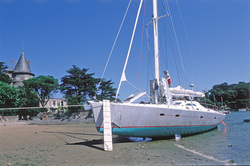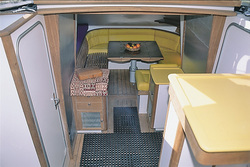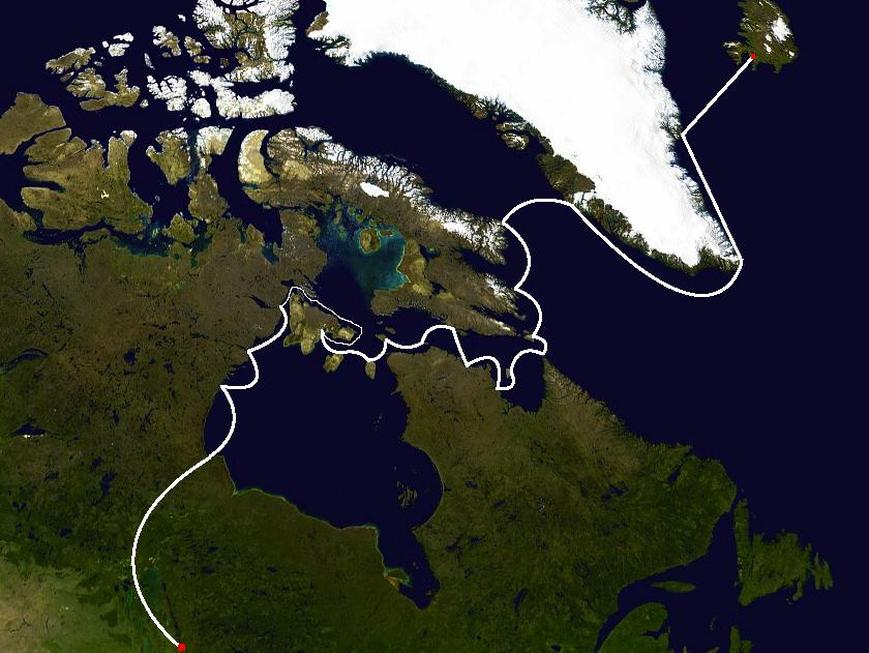Descendants of Vikings to set sail for Hudson Bay and beyond
Descendants of Vikings in North America 1,000 years ago will set sail on Lake Winnipeg this year for a voyage to Hudson Bay.
Those descendants, Winnipeggers Johann Sigurdson and David Collette, are on a hunt for traces of Norse explorers in Hudson Bay 800 years ago.
Ancient Viking sagas suggest Norse traders in narwhal and walrus tusks and polar bears may have slipped through the Northwest Passage during a brief period of global warming at the height of Viking settlements in Greenland and North America.
If they did, they may have made it as far as Hudson Bay.
"We've named the expedition Fara Heim," Sigurdson told the Icelandic Ice News this winter in an article that's circulating on archeological news websites. "In Old Norse, 'ao fara heim' means 'to go home,' " he said.
The pair will use this summer to raise funds and outfit a 15-metre sailboat with sonar and radar gear to collect data without digging anything up. They're hoping Icelandic shipping company Eimskip will ship the boat to North America this spring. It's due to launch in Lake Winnipeg this June.
The rest of this season, the expedition will work to generate public interest and attract sponsors and paying passengers for the search in the bay.
Plans next summer call for the crew to sail up the western coast of Hudson Bay, stopping at Inuit centres and talking to elders who might support information in the Norse sagas about a voyage to Hudson Bay.
"We're not going to one place to go and dig. We're going to focus on likely places with a Norse presence. We could be extremely lucky and find an outline of some buildings, like the stuff at L'Anse aux Meadows," Sigurdson said.
The 1,000-year-old base camp in northwestern Newfoundland is the earliest documented Viking settlement in North America.
Then they'll sail through the Northwest Passage, past Ellesmere Island, Skraeling Island and Ungava Bay where archeologists, anthropologists and historians from Thomas Lee to Icelandic speakers Tryggvi Oleson and Viljalmur Stefansson have all placed a Viking presence.
Fara Heim's advisory board includes a who's who of modern global explorers, adding credibility to the expedition.
The board includes Capt. Norm Baker, the first mate and navigator for Thor Heyerdahl of the famed Kon Tiki expedition, and Charles Hedrich, an explorer and founder of Respectons la Terre, a European group dedicated to exploration with an environmental focus. Filmmaker Guy Madden is another adviser.
The Glory of the Sea was the third yacht in history to make a sole voyage around Antarctica at latitudes below 69 degrees in 2003.
The Boat

“Glory of the Sea”

“Glory of the Sea” was built for its present owner in 2001 and launched in early 2002. After initial test sailing in western France, northern Spain and southern England she started her 3 year circumnavigation in late autumn crossing the Atlantic and heading for the Antarctic Peninsula. In February 2003 she became the third yacht in history to have attained a latitude below 69 degrees and 30 minutes south without outside assistance. She reached 69 deg. 47 min. in the bay of Magarite before being forced to turn. She spent the Antarctic winter in South Georgia and arrived in the spring in Cape Town in time for Christmas. She went on to visit 18 subantarctic islands in addition to Tasmania and New Zealand. She called in at a few islands in the south Pacific before returning to Patagonia and Ushuaia. She arrived back in France during the summer 2005. After having sailed an estimated 54000 nautical miles. The two Atlantic crossings, half the Indian Ocean crossing and three quarters of the Pacific crossing were done single handed.

“Glory” is a 50 feet aluminium sailboat designed, manufactured, equipped and, since its launch in early 2002 also used as an expedition support vessel in extensive ice sailing and polar winter situations. She is designed by naval architects Berret /Racoupeau and built by Alumarine. The interior design is by Patrick Roseo.
The hull is double skinned up to 30 centimetres above the water line. The space between layers, 10 centimetres, is filled with polyurethane foam forming a strong and insulating sandwich. It has four watertight bulkheads, twin lifting keels, twin lifting rudders and retractable propeller. The hull is water ballasted with three tanks either side inside the insulation. All transparent hull openings are double glazed or doubled with inside paneling. The engine is a MAN/NANNI four cylinder with keel cooling integrated in the hull. The rigging is cutter with pivoting wing mast and bowsprit for the gennaker and the asymmetric spinnaker.
The electrics is all 24 volt with three banks of batteries. One is for starting only and two for utilities. There is an emergency 12 volt system, mounted high in the boat, powering the radios and essential electronics. Charging is by twin engine mounted alternators when under power, solar panels, and propeller shaft driven alternator when under sail. Location and cabling is provided for wind generator.

The hull can be beached in two ways: Either on its bottom with all appendices retracted or standing on the keels and rudders. In the last case the height and angle of the hull can be adjusted by hydraulic cylinders attached between the keels and the deck.
For anchoring she is equipped with two large but lightweight anchors ready to go. Each anchor has a hundred meters of twelve millimeter chain in a chain box just behind the mast and next to the keel, thus keeping heavy gear away from the extremities of the hull.

The interior sleeps seven. The starboard cabin has twin fixed bunks and a fold down. The port cabin has a double bunk. There is a pilot bunk next to the inside steering position and one in the saloon. The saloon table can be lowered, providing a further double bed.
She is completely equipped for her purpose having just completed a 3 year 54000 nautical miles circumnavigation.
Expedition Objectives
The primary objectives for the Fara Heim expedition are:
1. Increase the awareness of Norse interactions with North America over the past 1,000 years
2. Travel via sailboat and search using advanced research technology for evidence of Norse presence in predetermined locations
3. Support and energize increased research into the Norse exploration, settlements and trading in areas west of Greenland
4. Educate and inform citizens of the Nordic countries on the history of Nordic exploration
The secondary objectives for the Fara Heim expedition are:
1. Increase the awareness of the global community to the nations of the North and their sovereignty
2. Measure and record environmental data for use in evaluating climate change
The team will train the crew and prepare the sailboat on Lake Winnipeg, Manitoba in 2012. The expedition will depart from Churchill, Manitoba in the early summer of 2013. The expedition will travel from Canada to Reykjavik, Iceland over a 3-month period while searching at predetermined locations for evidence of Norse presence.
The Route

(COMMENT - NORTHWEST PASSAGE PLANS NOT YET DOCUMENTED)
FAQs
Why?
The extent of the Viking / Nordic presence in North America is controversial. Questions go unanswered as many of the sites in the Arctic thought to be Viking have not been visited or studied for decades. The sites are remote and difficult to access. Consequently, the original studies with their information and conclusions continue to be recycled. New perspectives are nil. The aim of our project is to re-vitalize interest in this period of our history. We will review and share our knowledge of the accomplishments of these explorers and settlers. We will encourage contemporary study of the Viking presence in America by sailing the northern sea. We will share world wide the experience of being on-site via real-time video and photos. We will document our findings.
The extent of the Viking / Nordic presence in North America is controversial. Questions go unanswered as many of the sites in the Arctic thought to be Viking have not been visited or studied for decades. The sites are remote and difficult to access. Consequently, the original studies with their information and conclusions continue to be recycled. New perspectives are nil. The aim of our project is to re-vitalize interest in this period of our history. We will review and share our knowledge of the accomplishments of these explorers and settlers. We will encourage contemporary study of the Viking presence in America by sailing the northern sea. We will share world wide the experience of being on-site via real-time video and photos. We will document our findings.
How?
We are assembling an advisory team of respected professionals to assist us in locating known and suspected Viking sites around Hudson Bay and Hudson Strait. We will also identify other potential areas of investigation using satellite imagery, knowledge from Inuit elders, and extrapolated information by planning routes and segments particular to sailing vessels.
We are assembling an advisory team of respected professionals to assist us in locating known and suspected Viking sites around Hudson Bay and Hudson Strait. We will also identify other potential areas of investigation using satellite imagery, knowledge from Inuit elders, and extrapolated information by planning routes and segments particular to sailing vessels.
Why A Sailboat?
The Vikings were some of the most successful mariners of their time because of their ships: fast, light, shallow draft, and very seaworthy. Modern sailboats used in Arctic expeditions share many of these attributes and on that basis we will be able to access the same areas they did. By sailing these selected routes and segments, we will become “Viking”. We will visualize the land and sea from the perspective of the deck of a small sailing ship.
The Vikings were some of the most successful mariners of their time because of their ships: fast, light, shallow draft, and very seaworthy. Modern sailboats used in Arctic expeditions share many of these attributes and on that basis we will be able to access the same areas they did. By sailing these selected routes and segments, we will become “Viking”. We will visualize the land and sea from the perspective of the deck of a small sailing ship.
Why Not A Replica Of A Viking Ship?
This expedition is not an attempt to show that Vikings could have sailed here. It is a known fact that they had the technology (ships) and the skill to go almost anywhere they wished. Therefore, our sailing east does not require a replica of a Viking ship. Our focus is to visit the known and suspected sites while searching for new possibilities. To do this, we will follow the guidelines of the intrepid Viking explorers and select the most modern and well-equipped vessel available for our northern exploration. The areas we are visiting, northern Hudson Bay, Hudson Strait, and Baffin Island, have challenges enough for any modern sailor. Modern Vikings, on voyages of re-discovery, need all the safety equipment available. They can then concentrate on finding evidence of “those who were here before” and ensure a safe journey.
This expedition is not an attempt to show that Vikings could have sailed here. It is a known fact that they had the technology (ships) and the skill to go almost anywhere they wished. Therefore, our sailing east does not require a replica of a Viking ship. Our focus is to visit the known and suspected sites while searching for new possibilities. To do this, we will follow the guidelines of the intrepid Viking explorers and select the most modern and well-equipped vessel available for our northern exploration. The areas we are visiting, northern Hudson Bay, Hudson Strait, and Baffin Island, have challenges enough for any modern sailor. Modern Vikings, on voyages of re-discovery, need all the safety equipment available. They can then concentrate on finding evidence of “those who were here before” and ensure a safe journey.
Who Will Be On The Expedition?
It takes vision and commitment to launch the sort of expedition we are organizing. It will take months of work to organize, finance, and carry out this investigation. The core team members are Johann Sigurdson and David Collette. Additional crew including those whose specialized skills are critical to the success of the journey and a few others who wish to join us in 1-2 week segments for “travel with a purpose”. The final crew complement and schedule will be developed as the project moves forward.
It takes vision and commitment to launch the sort of expedition we are organizing. It will take months of work to organize, finance, and carry out this investigation. The core team members are Johann Sigurdson and David Collette. Additional crew including those whose specialized skills are critical to the success of the journey and a few others who wish to join us in 1-2 week segments for “travel with a purpose”. The final crew complement and schedule will be developed as the project moves forward.
Who Is Advising The Expedition?
There is tremendous interest in this project. Experts in archaeology, anthropology, Arctic expedition planning, sea ice, documentary film, finance, and Viking Age history have offered assistance. We are grateful to them. From this group, we have formed an advisory committee with the directive of establishing guidelines to ensure the project’s success. We trust that the outcome will encourage more investigation concerning the extent of the Norse presence in North America.
There is tremendous interest in this project. Experts in archaeology, anthropology, Arctic expedition planning, sea ice, documentary film, finance, and Viking Age history have offered assistance. We are grateful to them. From this group, we have formed an advisory committee with the directive of establishing guidelines to ensure the project’s success. We trust that the outcome will encourage more investigation concerning the extent of the Norse presence in North America.
Sponsor Brochure: http://faraheim.com/uploads/2/9/3/9/2939940/fara_heim_brochure.pdf

No comments:
Post a Comment
Enter your comment(s) here...